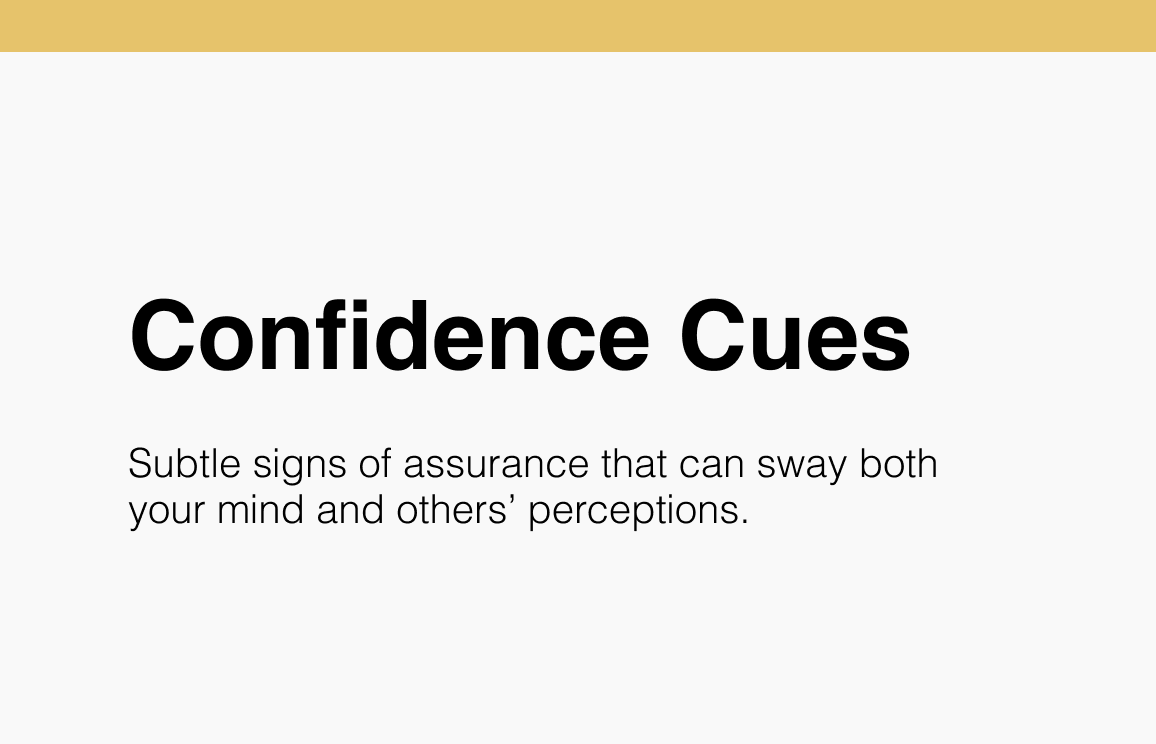20 Things You Should Know About Confidence Cues
Enhance your personal presence and influence by understanding Confidence Cues—what they are, why they matter, and how they shape both how others perceive you and how you feel about yourself. Discover how mastering these subtle signals can boost your self-assurance, improve communication, and elevate your professional and personal interactions.
1. What Are Confidence Cues?
Confidence cues are the verbal and nonverbal signals—such as posture, tone, and facial expressions—that convey self-assurance to others.
2. Shaping First Impressions
These cues play a crucial role in forming first impressions, often determining how trustworthy and capable you appear in new interactions.
3. The Power of Body Language
Strong, open body language like upright posture and relaxed gestures signals confidence and openness.
4. Eye Contact Matters
Maintaining steady and natural eye contact communicates engagement and assurance, fostering connection and trust.
5. The Role of Voice and Tone
A clear, steady voice with varied intonation can project confidence and authority in conversations and presentations.
6. Facial Expressions
A calm and genuine smile or a composed expression can serve as a powerful cue that you’re confident and approachable.
7. Dressing for Confidence
Your choice of attire and grooming not only influences how others see you but can also boost your self-confidence.
8. Assertive Gestures
Purposeful hand movements and open gestures help reinforce the message that you’re confident in what you’re saying.
9. Positive Self-Talk
The way you speak to yourself internally affects your external cues—affirming self-talk boosts your overall confidence.
10. Controlled Breathing
Deep, steady breaths can help maintain calm and regulate nervous energy, ensuring your confidence cues remain steady.
11. Consistency in Cues
Consistently displaying confident behavior builds a strong personal brand and reinforces how you view yourself.
12. Adaptation to Context
Understanding that confidence cues can vary by culture and setting helps you adjust your behavior for different environments.
13. The Impact on Communication
Confident cues not only enhance your own presence but also improve how effectively you convey your ideas to others.
14. Role in Leadership
Leaders who master confidence cues often inspire trust, motivate teams, and drive decisive action.
15. Training Your Cues
Regular practice—like role-playing or mirror exercises—can help you become more aware of and improve your nonverbal signals.
16. Feedback and Reflection
Seeking constructive feedback on your body language and tone can help you refine your confidence cues over time.
17. Overcoming Self-Doubt
By consciously projecting confidence, you can start to shift internal narratives, reducing self-doubt and reinforcing a positive self-image.
18. Using Silence Effectively
Pausing before speaking or during conversations can be a subtle cue of thoughtfulness and confidence, allowing your words to carry more weight.
19. The Ripple Effect
Strong confidence cues can influence not only personal interactions but also your overall mindset, leading to enhanced performance and well-being.
20. Related Topics to Explore
- Self-Efficacy Calibration – Learn how aligning your self-beliefs with your abilities builds lasting confidence.
- Adaptive Confidence – Discover strategies to adjust your confidence levels to meet changing challenges.
- Self-Talk Restructuring – Transform negative internal dialogues into empowering narratives.
- Grit Priming – Explore techniques to strengthen perseverance and determination.
- Intrinsic Motivation Cultivation – Understand how internal drives contribute to authentic, sustainable confidence.
Quick Tips to Boost Your Confidence Cues
- Practice Good Posture: Stand and sit with your shoulders back and your head held high.
- Maintain Eye Contact: Engage with others by keeping natural, steady eye contact during conversations.
- Use Positive Self-Talk: Replace self-doubt with affirmations that reinforce your capabilities.
- Dress the Part: Choose attire that makes you feel professional and confident.
- Seek Constructive Feedback: Ask trusted peers for input on your nonverbal signals and adjust accordingly.
Embrace these insights and tips to harness the power of Confidence Cues, empowering you to project self-assurance, enhance your interactions, and achieve greater success in every area of your life!

